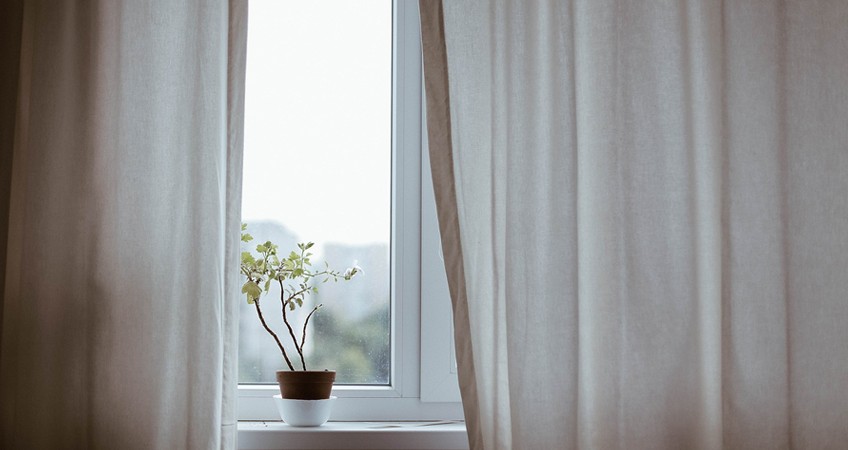Curtains are the finishing touches to the appearance of any home. This is why the wrong curtain choice can really harm your home’s pattern and texture. Looks aside, window curtains also serve a practical purpose. They offer privacy and provide warmth which helps cut down your energy expenditure. So how does one choose the right curtains for their windows? First up, decide which style you want for your home; casual, contemporary or traditional. Once that’s sorted out, you can focus on other aspects like fabric, pattern, and style of the curtain. Without further ado, let’s look at the basics of how to choose window curtains for your home.
Readymade or Bespoke
Window curtains are available in two types, readymade and bespoke. As obvious from the name, readymade refers to mass produced curtains while bespoke curtains are made specifically for your needs. There are advantages and disadvantages to both.
1) Readymade curtains
They are cheaper than their made-to-measure counterparts. You can simply walk into the nearest store and take your pick from a vast range of curtains. They are usually made of washable cotton and offer an eclectic choice of colours and shades. The convenience offered by readymade curtains is unmatched and since they’re washable, keeping them clean is a piece of cake.
While a low cost is one of the offshoots of mass production, so is standardisation. That means your choice of curtains is confined to standard lengths and widths. Moreover, there’s a good chance that the specific pattern or shade you want might not be available. Mass produced window curtains are also known to be inconsistent in quality, which is why it’s recommended to always unwrap and thoroughly check a readymade curtain before buying it.
2) Bespoke curtains
Also known as made-to-measure curtains, they are ideal for windows of unusual shapes and sizes. Bespoke curtains are also useful if you’d like them to complement your room’s furnishings. Although it can be done using readymade curtains too, you’ll either have to spend a lot of time searching or get really lucky.
When you go bespoke, you are free to choose the size, fabric, heading and lining you want. This way, it becomes easier to create curtains that match the overall appearance of your home. On the downside, as is the case with anything made-to-measure, handmade curtains are pricey and cannot be assigned easily to another window. There is also the fact that you’ll need to get them tailored from a skilled set of hands as even the slightest mistake can prove costly.
The Choice of Fabric
The choice of curtain fabric should be based on practical considerations first, with style coming next. For example, if privacy is your topmost concern, medium or heavyweight curtains are excellent options thanks to their daylight blocking ability. Just remember to extend the curtain pole beyond the window’s frame so that the fabric doesn’t obstruct light when you keep the curtains open. If you want to let in some light without losing privacy, use lightweight sheers along with the curtains. But if privacy and draughts aren’t much of a concern, unlined curtains and sheers (either with or without a blind) are worth considering.
If draughts lash your home frequently, consider heavier fabrics like velvet and wool. You can also use medium weight fabrics for the purpose, provided they are lined and interlined. Lightweight fabrics are great if you prefer to have some daylight filter through. Pale colours on the other hand, tend to reflect daylight.
The choice of curtains doesn’t have to remain the same throughout your home. While bedroom curtains and drapes need to offer greater privacy, the best curtains for the living room are the ones that offer a good balance between privacy and illumination.
Which Type of Heading?
Curtains are hung off poles or tracks in various ways. These are also known as headings.
1) Eyelet – In this heading, metal rings are punched along the curtain’s top and the hanging pole is passed through these rings. Eyelets are perfect for medium weight and unlined fabric curtains.
2) Goblet pleat – Ideal for tall windows that are draped in heavyweight fabrics, these headings have a cylinder at the top that is formed by the large pleats.
3) Pencil pleat – Offering a formal and regular pleated look, pencil pleats suit light and medium weight curtain fabrics. They are also ideal for long drapes.
4) Pinch pleat – A heading that’s suitable for medium weight curtain fabrics, it involves pinching three folds of the fabric into a pleat at fixed intervals. For larger patterns, pinch pleat headings are great options.
As a final point, you’ll need to choose between poles and tracks to hang your curtains off. The latter is great if you have large or curved windows. However, they are not as attractive as poles, which are not only available in plenty of different materials and sizes but also come fitted with decorative end pieces. And although poles sit better on straight windows, there is a workaround in the form of bending sections. In the end, take your time browsing through all options as with curtains, there is no going back. At least not without blowing a hole in your wallet.


